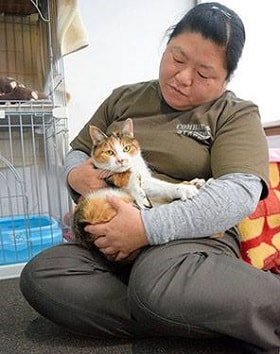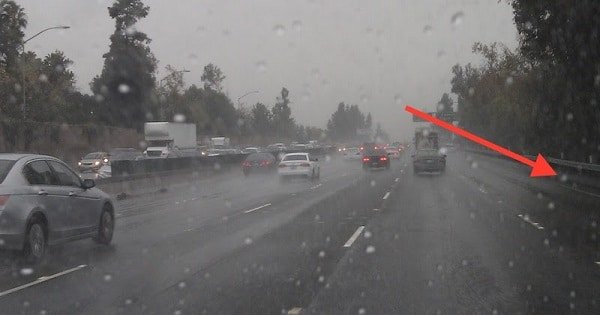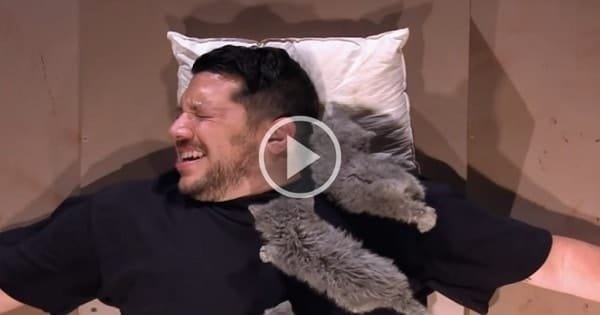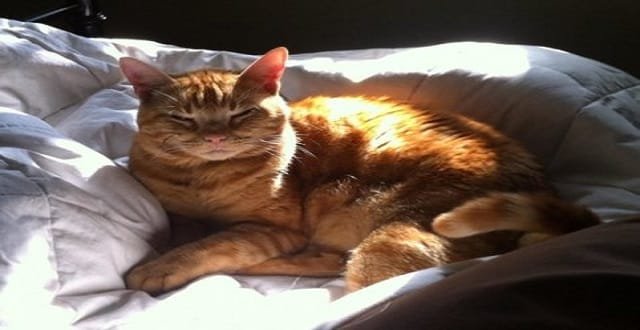FUKUSHIMA, JAPAN – They are no in the middle of another tough winter. The head of a private group founded in this town to rescue cats left behind when residents evacuated from the nuclear accident worries about their continued survival. Five years have already passed.
“Surviving the winter will be tough for cats since the animals don’t endure the cold weather very well,” said Akira Honda, who operates the Nyander Guard.
“We want to save all the lives left behind in the difficult-to-return zone and elsewhere,” he said, in reference to the off-limits area around the crippled Fukushima No. 1 nuclear power plant.
In December, Fukushima prefectural officials closed a shelter for pets abandoned by their owners, concluding that nearly five years after the nuclear disaster, it is highly unlikely that any of them remain in the restricted area.
However, efforts are still ongoing by private groups to retrieve cats left behind by their evacuating owners.
In one such “rescue mission,” Takemi Shirota, a staff member with the Nyander Guard, traveled to Okuma, which co-hosts the plant and is located in the “difficult-to-return” zone, in November.
The zone is where annual radiation exposure levels exceeded 50 millisieverts as of the end of March 2012, which is well beyond the permitted additional exposure of 1 millisievert a year for the public.
Evacuees from the zone are now allowed visits to their homes if they obtain a permit from the central government and local authorities.
Shirota’s search in the difficult-to-return zone was arranged to coincide with a few special day trips by displaced residents.
When she went to check on cages with food placed the day before to capture cats, she discovered a calico cat inside one of them.
The calico, still wearing a collar, looked shabby after many years of roaming in the wild.
When Shirota, 39, reached to pick up the animal, it did not resist at all.
“This cat must have had an owner before the accident,” she said.
The Nyander Guard is now trying to find the cat’s owner through its website.
The group conducts a search in accordance with requests from a pet owners.
To assist in its search, it uses surveillance cameras set up in specific sections in the zone after they have gained permission from affected landowners and home owners.

The feline is believed to be just one of many pets that their owners could not take with them as they fled soon after the triple meltdown unfolded at the nuclear complex on March 11, 2011, following the Great East Japan Earthquake and tsunami which followed.
About 24,000 people from the difficult-to-return zone, to date, remain displaced, and it is still uncertain as to when they can return to resume their normal lives.
Some displaced residents regret that they did not take their pets with them, regardless of the terrible circumstances.
A middle-aged woman from Tomioka, which is a town next to Okuma, gave up on taking her cat with her when she fled to Koriyama, also in the prefecture.
Her reason was that keeping her cat in a shelter would have been virtually impossible, with a large number of evacuees crowded into a limited space.
Each time she returned to her home upon temporary visits, the feline was there waiting to be fed.
Later, the cat disappeared.
After seeing a photo of a feline resembling hers at the Nyander Guard’s website, the woman went to the cat shelter which is operated by the group to check it out.
In the end, the cat was not hers, after all.
“I should have evacuated with my cat, no matter what,” the tearful woman told the staff.
Honda, the president of an automotive parts manufacturer, moved to Fukushima Prefecture from Nagoya, right where his company is based, to launch efforts to rescue animals in April 2011.
In December the same year, Honda also purchased a rental house in Miharu to turn it into a shelter for cats.
Apart from Honda and Shirota, a total of four other staff members are involved in the Nyander Guard.
Honda, 52, shuttles between Nagoya and Miharu to juggle his own business and rescue operations.
The group has captured in upwards of 400 cats so far and tries to track down their owners or find them new homes.
About 60 cats from the difficult-to-return zone remain under its care today, most are believed to have been born after the nuclear disaster.
Honda said it costs more than 2 million yen ($17,000) a month to finance their activities, including utilities, food and personnel costs.
He covers the difference out of his own pocket because donations from organizations and individuals, as well as subsidies from the prefectural government to fund part of the manpower costs, are just not enough.
The Nyander Guard is not the only group still leading rescue efforts.
Private groups and individuals in and outside the prefecture have engaged in some efforts to retrieve dogs and cats in the stricken area at their own expenses.
The Fukushima prefectural government, too, launched a search for pets in the “no-entry” zone, a radius of 20 kilometers from the Fukushima plant, one month after the nuclear accident occurred.
The number of dogs and cats that were captured and kept at a shelter under this initiative numbered exactly 463 and 545, respectively, over the past four years and eight months, according to prefectural officials.
Of these, about 30 percent of the animals were later returned to their owners and new homes were found for about 60 percent. The remainder died while in the shelter.
Heeding requests by many evacuees, the central government revised the Basic Disaster Management Plan in December 2011, incorporating a clause calling for reserving space for pets at various evacuation centers.
Still, many pets will likely be left behind when residents are forced hurriedly to evacuate, as was demonstrated when torrential downpours managed to flood large areas in the Kanto and Tohoku regions last September.
“People should be ready with a contingency plan before an emergency hits,” said Shirota, who serves as the chief of the Nyander Guard’s shelter.
Today, efforts have now stretched more into re-homing the remaining cats and dogs.
“I have seen many dead cats, many dogs who starved to death,” Shirota said.
Back at the shelter, the staff still struggles to find people who are willing to adopt the animals. “In Japan, people still buy their pets from pet shops,” Shirota said. “Being a foster owner of cats and dogs is kind of a new idea for them.”
The dogs are for the most part, generally healthy, but the cats appear less so.
Shelter workers suspect that being lower to the ground and licking their fur may have exposed them to more radioactive particles and sometimes they just die for no apparent reason.
There is one cat currently at the shelter is named Kevin Costner. The owner told shelter workers that he was a fan of the movie star but he didn’t realize that the gray tabby was a female.
“Kevin hates other cats,” Shirota said. “But the volunteers and staff really like her.”










